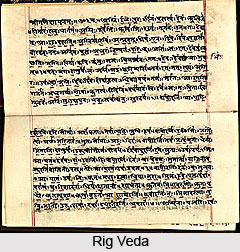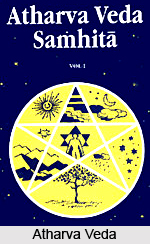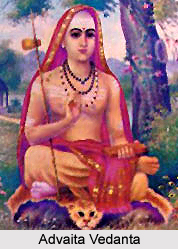 Vedic literature glorifies Vedic India. "Vedas", a Sanskrit phrase, implies knowledge. It is the traditional faith that Vedas are "apuruseya" (not composed by human beings), which was known to be a direct revelation of God, hence named shruti. Scholars believed that Vedic Literature originates long before the literary tradition started in India. However the oldest text, Rig-Veda has been traced back to the 11th century. The Vedic literature consists of the Vedas, Upanishads, Vedangas, Sutras, Upavedas, Shastras and Puranas.
Vedic literature glorifies Vedic India. "Vedas", a Sanskrit phrase, implies knowledge. It is the traditional faith that Vedas are "apuruseya" (not composed by human beings), which was known to be a direct revelation of God, hence named shruti. Scholars believed that Vedic Literature originates long before the literary tradition started in India. However the oldest text, Rig-Veda has been traced back to the 11th century. The Vedic literature consists of the Vedas, Upanishads, Vedangas, Sutras, Upavedas, Shastras and Puranas.
The Vedic period lasted for a millennium encompassing the late bronze & Iron Age. As far as the researches are concerned, the Vedic Literatures are composed in 1500 B.C, over a period of years. Vedic Literature saw its crest after the composition of the mantra texts, frequently called Samhita texts. With the composition of the mantra texts, shakas were established all over northern India. Usually Shakas are the theological schools that were focused on the learning of the Vedic Mantras.
The Vedas can be classified into categories of texts, traditionally the Samhitas or mantras, Brahmans, Aryanyak and Upanishads. The Vedas, as often termed as the Sutra literature can also be classified into Shrautasutras and Grahyasutras.
The Vedic Samhitas or the Mantras are mainly the metric texts and there are four Vedic samhitas- Rig Veda, Sama Veda, Yajur Veda and Atharva Veda. Sometimes the term "Vedas" is used to signify those Samhitas. The Samhitas are the oldest stratum of Vedic texts. As "Vedic Concordance" of Bloomfield, an eminent scholar records, Vedas have 89000 padas, of which 72000 are in Samhitas.
 The Rig Veda: This oldest existing Indian text is an anthology of 1028 hymns and 10,600 verses devoted to the Rig Vedic deities, compiled in 10 mandalas or books. According to the different opinions forwarded by the historians, saints composed Rig Veda for a period of 500 years in the Sapta – Sindhu, present day Punjab region of Indian Subcontinent. The Indian Rig Veda is closely synonymous with the Iranian and Andronovo culture.
The Rig Veda: This oldest existing Indian text is an anthology of 1028 hymns and 10,600 verses devoted to the Rig Vedic deities, compiled in 10 mandalas or books. According to the different opinions forwarded by the historians, saints composed Rig Veda for a period of 500 years in the Sapta – Sindhu, present day Punjab region of Indian Subcontinent. The Indian Rig Veda is closely synonymous with the Iranian and Andronovo culture.
The Sama Veda: The name "Sama" derived from the word "saman" means the "song of praise". The Sama Veda is the "Veda of chants" or "Knowledge of melodies". Sama Veda is a compilation of 1875 verses, some of which are the repetitive imitations of the Rig Veda. It serves as a song book for the priests who take part in public worship. A priest singing in the rituals is commonly called "udgati" or "cantor". A fixed style was followed by the priests while enchanting. Two major shakas are associated with this Veda- Ranayianiya and Jainimiya.
The Yajur Veda: It consists of cryptic prose mantras, some parts are borrowed from the Rig Veda. Each of the mantras in the Yajur Veda are associated with specific sacrificial rites, not merely Soma offering. Two major recessions of the Yajur Veda are "White" & "Black". The "White" discusses only those verses required for the sacrifices but do not explain the implication of those verses but the "black" Yajurveda contain specific explanations of the work to be performed.
The Atharva Veda: depicts the "Knowledge of the Atharvans" or the "Agnisara". As it has been pointed by Apte, the scholarly historian, "atharvan" is a priest who worships fire and Soma. It is a collection of 760 hymns and about one-sixth hymns are the imitation of Rig Veda. The Atharva Veda has least connection with the sacrifices and rituals but involves the incantations required for prevention of demons and disasters.
 The Brahmanas are the prose literature, codified in a procedural fashion, which depicts the sacrificial rituals, their meanings and a complete commentary on the usage, implication and their significant effect of those rituals. Brahmanas are considered to be the heart of Indian Philosophy, describing the concepts of Karma and Samsara and the significance of the four stages of the life of a Hindu Brahmin, namely- Brahmacharya, Grihasthya and Vanprastha and Sanyas. It also provides a perception of the spirituality and supernaturalism of the Vedanta philosophy. Each of the Brahmans are associated with one of the Samhitas and according to that one of the shakas or schools. The Brahmans may also include the Aryanaka or the Upanishads.
The Brahmanas are the prose literature, codified in a procedural fashion, which depicts the sacrificial rituals, their meanings and a complete commentary on the usage, implication and their significant effect of those rituals. Brahmanas are considered to be the heart of Indian Philosophy, describing the concepts of Karma and Samsara and the significance of the four stages of the life of a Hindu Brahmin, namely- Brahmacharya, Grihasthya and Vanprastha and Sanyas. It also provides a perception of the spirituality and supernaturalism of the Vedanta philosophy. Each of the Brahmans are associated with one of the Samhitas and according to that one of the shakas or schools. The Brahmans may also include the Aryanaka or the Upanishads.
The Aryanakas or the "wilderness texts" composed the concluding part of the Brahmans. These are the religious Scriptures or the treatise about the saints living in the forests. The Aryanaka argues about the philosophy & sacrifice. The Aryanaks offers a profound implication and interpretation of the philosophy in the Vedas as contrasted to the Brahmans, which only offers a systematic procedure of the rituals. The Aryanaks are further classified into several parts and named after the specific shakas they are associated with. Aitereya Aryanaka is associated with Shakala Shaka of Rig Veda, Taittiriya Aryanaka belongs to Taittiriya Shaka of Krishna- Yajur Veda, Kaushitaki Aryanaka belongs to the Kaushitaki and Shankhayana Shakas of Rig Veda, Kattha Aryanaka is a part of Katha charaka sakha of Krishna - Yajur Veda. Maitrayana Aryanaka, Talavakara Aryanaka, Charaka Aryanaka, Brihada Aryanaka, Shankhanya Aryanaka etc are also the subcategories of the Aryankas. Aryanakas are addressed as "Rahasya Brahmanas" by Durgacharya in Nirukta because the Aryanakas offers cryptic meaning to the ritualistic dealings as described in the Brahmanas. Aryanakas confirms the fact in spite of the multiplicity of the Vedic Literature a continuous thread of "Absolute Reality" that runs through all. The language of the Aryanakas is more akin to the earliest version of Sanskrit language.
The Upanishads are the philosophical works in a conversational form. Philosophy of nature & the fate of soul, procedures of meditation & the nature of God are the principal themes discussed in the Upanishads. They have been acknowledged as the concluding part of the Vedas, which form the Vedanta. The Sanskrit term implies "sitting down beside" The Upanishads are summarized in one phrase "Tat Tvam Asi"(That thou art) by Advaita Vedanta, which believes in the ultimate truth "Brahma". The Upanishads open with the word "aum", considered to be a divine word that underlies the philosophy of existence of being in one self. There are 11 principal (mukhya) Upanishads- Aryanaka, Brhadarnaka, Isha, Taiterreya, Katha, Chandogya, Kena, Mundaka, Mundyaka, Prasna, Svetasvatara. The Older Upanishads are traced back to have some connection with Vedic Charanas. Shakta Upanishads upheld the interpretive difference between two principal sects of Srividay Upasana.



















